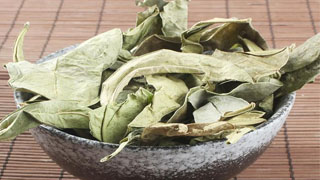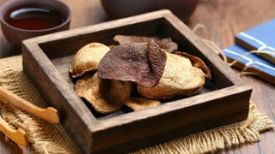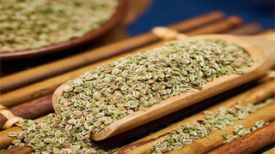
1. Alias
Dragon Lily Leaf, Dragon Tongue Leaf, Dragon Flavor Leaf.
2. Plant morphology
Evergreen small shrubs. The branches are twisted and leaning at the bottom. Leaves alternate, slightly fleshy, inverted needle shaped or oblong spoon shaped, rounded at the top, wedge-shaped or gradually narrowed at the base, dark green or light blue-green above, often pale white near the midrib and lateral veins. Purple red flowers, very small, unisexual, monoecious, with several male flowers clustered or forming axillary cymes, and 1-2 female flowers often growing in leaf axils; The sepals of male flowers are disc-shaped and have three stamens; The sepals of female flowers are spiral shaped, and the ovaries have 3 chambers with 2 ovules per chamber; Both male and female flowers have no petals. The capsule is as large as a pea, flattened in shape, and covered with a persistent calyx.
3. Origin distribution
Commonly cultivated in gardens and courtyards. Originating from Sumatra. It is planted in Guangdong, Guangxi, Yunnan, Fujian, Hainan and other places, with Guangdong and Guangxi being the most cultivated.
4. Harvesting and processing
Harvested from April to October, with June to August being the peak production period. Pick green old leaves every 15-20 days, with 3-4 leaves from top to bottom per plant, and dry in the shade (not directly exposed to sunlight, otherwise the leaves will turn yellow in color); When dried in the shade to 70-80% dry, fold the leaves together and tie them into small bundles, cover them with a mat, and sun dry them until they are fully dry.
5. Characteristics of medicinal herbs
Shrinking in a clustered or elongated shape, flattened to form a long oval, ovate lanceolate, or inverted lanceolate shape, resembling a tongue like shape, with a rounded and slightly concave tip and small spikes. The base is narrow and wedge-shaped or slightly rounded, with the entire margin. The leaf surface is dark green, often with gray white spots, and the back of the leaf is yellow green. The midrib is prominent, with occasional soft hairs at the base. The lateral veins are feather shaped, with 5-6 pairs, and close to the outer edge. Hard paper, slightly thick. Slightly fragrant, with a light and slightly sweet taste.
6. Sexual Taste Returning to the Classics
Flat in nature, sweet and light in taste. Return to the lung meridian and stomach meridian.
7. Effect and Function
Moisturize the lungs, relieve cough, and promote bowel movements. It belongs to the category of cough and asthma relieving drugs under the category of phlegm resolving cough and asthma relieving drugs.
8. Clinical application
Take 10-15 grams and decoct. Used to treat lung dryness, cough, sore throat, and loss of voice.
9. Pharmacological research
The extract of Longlei leaves has significant antagonistic effects on both acute and chronic inflammation, and has peripheral analgesic effects, but no central analgesic effects; It has strong antibacterial effects on Staphylococcus aureus, drug-resistant strains of Staphylococcus aureus, Escherichia coli, Pseudomonas aeruginosa, Streptococcus pyogenes A and Streptococcus pyogenes B.
10. Chemical composition
Contains components such as steroids, amino acids, peptides, and proteins.
11. Usage taboos
Not yet clear.
12. Compatibility prescription
① To treat phlegm, fire, and cough: Take a decoction of dragon carp leaves and pork. (Lingnan Medicinal Collection Record)
② For the treatment of acute bronchitis, upper respiratory tract inflammation, and bronchial asthma: 6-12 grams (fresh 9-30 grams) of dragon carp leaves. Boil it in water. The content of the "Commonly Used Chinese Herbal Medicine Handbook" by the Guangzhou military is for clinical reference only. Non TCM professionals are not allowed to test the medicine.
⊙ Some of the images and text are sourced from the internet. If there is any infringement, please contact us to delete them.


